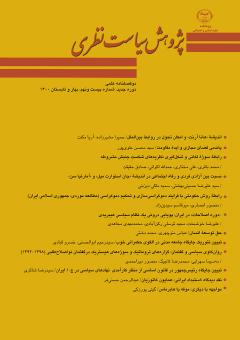تبیین تئوریک جایگاه جامعه مدنی در الگوی حکمرانی خوب
محورهای موضوعی : Research in Theoritical Politicsسیدرحیم ابوالحسنی 1 , خسرو قبادي 2
1 - دانشیار گروه حقوق و علوم سیاسی، دانشگاه تهران
2 - استادیار گروه علوم سیاسی، پژوهشگاه علوم انسانی و مطالعات اجتماعی جهاددانشگاهی و دانشآموخته دکتری علوم سیاسی دانشگاه تهران، ایران
کلید واژه: جامعه مدنی, اقتصاد سیاسی, رویکرد فرهنگی, هنجار و حکمرانی خوب. ,
چکیده مقاله :
در الگوی حکمرانی خوب، سه بخش دولتی، خصوصی و جامعه مدنی با مرزهای جداگانه و در یک رابطه تعاملی به منظور رسیدن به اهداف توسعه با یکدیگر همکاری میکنند. این الگو با رویکرد رایج از جامعه مدنی بر اساس برداشت هگلی که بر پایه اقتصاد سیاسی و مبتنی بر کشمکش است، سازگاری ندارد. حال این پرسش قابل طرح است که در غیاب و یا کمرنگ شدن نقش اقتصاد و سیاست در تعریف و تبیین جامعه مدنی، با کدام مبنا و رویکرد میتوان این مفهوم را در مدل حکمرانی خوب تبیین کرد؟ مدعای مقالۀ حاضر آن است که رویکردهای فرهنگی به جامعه مدنی و از جمله رویکرد جفری الکساندر، بیشتر میتواند جامعه مدنی را در الگوی حکمرانی خوب تبیین کند. در این مقاله به وجوه این تبیین و چگونگی آن با روش توصیفی و تحلیلی پرداخته شده است. روش گردآوری اطلاعات، اسنادی و کتابخانهای است و با رجوع به منابع معتبر و تحلیل آنها، مستندات برای آزمون فرضیه (مدعای) مقاله ارائه شده است.
In the model of good governance, the three sectors of public, private, and civil society work together with separate boundaries and in an interactive relationship in order to achieve development goals. This model is inconsistent with the current approach of civil society based on the Hegelian conception, which is based on political economy and conflict. Now the question can be asked that in the absence or diminishing role of economics and politics in the definition and explanation of civil society, with what basis and approach can this concept be explained in the model of good governance? The present article argues that cultural approaches to civil society, including Jeffrey Alexander's approach, can further explain civil society in terms of good governance. In this article, the writers discuss some aspects of this explanation by a descriptive and analytical method. The method of data collection is documentary and library, and by referring to reliable sources and analyzing them, documents have been provided to test the hypothesis of the article.
